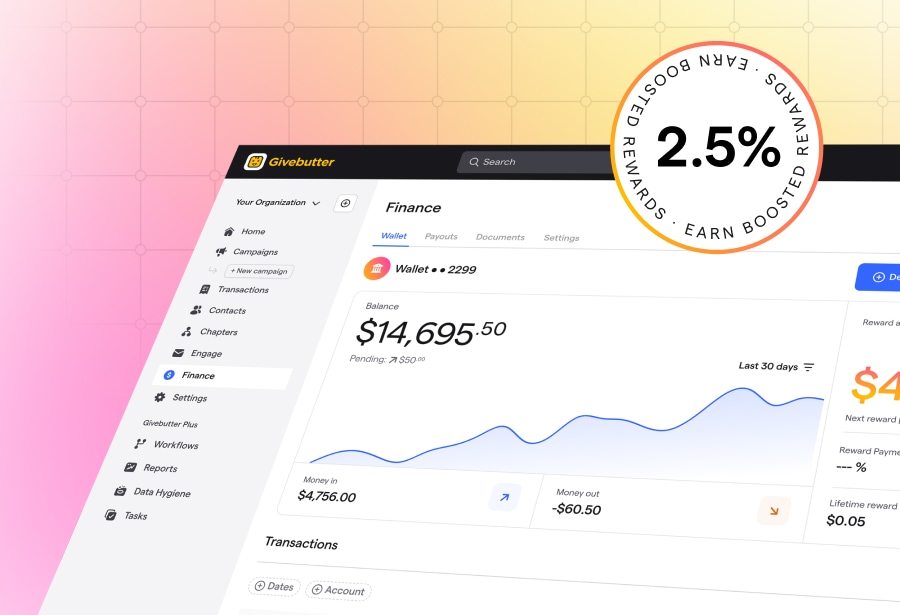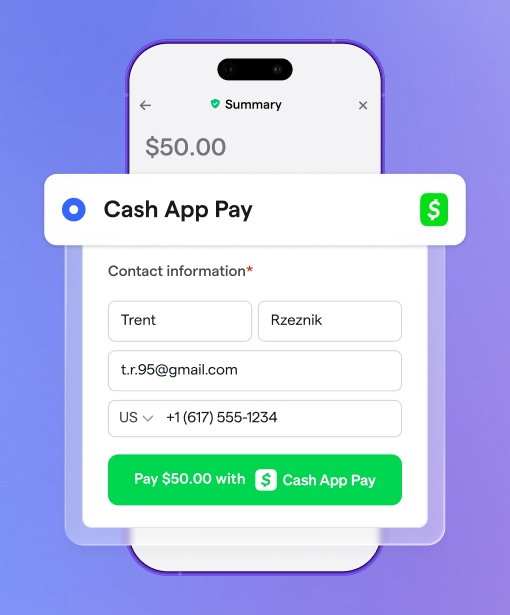Table of contents
Table of contents
Cast your mind back to the most memorable event you’ve ever attended.
Perhaps it was a wedding or an elaborate scavenger hunt birthday party hosted by friends. Whatever the event, you can be sure it was carefully managed behind the scenes—from choosing a location to welcoming guests, and expressing gratitude once the event was over.
If you thought of a nonprofit charity fundraiser, you’re not alone—81% of people have attended a fundraising event. Fundraisers are a popular and effective way to connect with your supporters and raise money for your cause.
Event management for nonprofits might seem intimidating, but with the right approach, you can organize a seamless and successful fundraiser.
What is nonprofit event management?
Nonprofit event management is the process of planning and overseeing every detail of your event—from your initial event idea to keeping on top of the details when the big day rolls around.
Nonprofit event management encompasses essential steps like choosing an event location, event ticketing, collecting donor information, and establishing meaningful connections during your event.
Master nonprofit event management in 7 steps
While every nonprofit event is different, the steps to a smooth, profitable event are the same.
Before you dig into the details, consider the bigger picture: What are your goals for the event, and how will it help advance your mission?
Below, we’ll walk you through everything you need to ensure your event is fun, memorable, and—perhaps most importantly—profitable.
1. Set goals 🎯
Determine your fundraiser’s goal. Are you launching a new program or generating revenue to fund existing programs for six months?
Your goal will help you determine the amount of money you need to raise, which in turn informs your nonprofit event budget.
💪 Pro tip: Set both a public and private SMART fundraising goal. Public goals should be mission-specific so your supporters can visualize how they’re helping your cause through participating in your event—like funding 100 scholarships or feeding 500 families. Your private goal might be to increase attendance by 30% or boost your profits by 10% over last year.
2. Determine your budget 💰
Make a budget—and stick to it.
Overspending could mean your event costs more than you’re able to fundraise. But you’ll also want to make sure you spend enough to create a memorable event for your attendees.
Compare multiple quotes for catering and venues, as these are likely to be your most significant expenses.
💪 Pro tip: Don’t overspend on event software. Keep overhead low by using free fundraising and nonprofit event management software like Givebutter.
3. Choose a date and venue 🏰
Decide the number of guests you’d like to host and ensure your chosen venue aligns with your vision.
Accessibility is another important consideration: Is there plentiful parking? Is your venue reachable by foot or public transit?
The right tools can help you stay organized. Givebutter’s table seating tools make it easy to assign guests to tables, manage VIP sections, and make last-minute changes.
💪 Pro tip: Planning a walk-a-thon, gala, or golf tournament? Simplify signups and boost participation with registration fundraising—Givebutter’s innovative way to combine event signups and peer-to-peer fundraising in one seamless flow. Every registration can double as a fundraiser, helping you raise more without extra effort.
4. Take care of the details 🥘
Many event venues have partnerships with caterers and entertainers, which can help streamline planning.
Remember to include a unique element to your event—whether it’s a creative theme, a surprise guest, excitement-generating raffle prizes, or special recognition for high-ticket donors. With Givebutter, you can sell online raffle tickets, track entries, and draw winners—right from your event dashboard.
Hosting an auction? You can add items, manage bids, and collect payments all in one place with Givebutter’s built-in auction tools.
💪 Pro tip: Use workflows in Givebutter Plus to handle small but important details prior to your event. For example, you can automate guest registration for bidding ahead of your fundraising auction.
Having the ability to run a silent auction, sell tickets, and accept donations in lieu of ticket purchases (or in addition) was a game-changer that led us to nearly double our annual event’s overall income. The platform is very intuitive and live chat support seven days a week was very helpful! — Givebutter Review, Emily K.
5. Create a sponsorship package 🎁
Corporate sponsorships are a great way to raise funds and lower overhead costs. Decide what you’ll offer your corporate sponsor in return for their contribution.
Perhaps you include their logo on your marketing materials, website, or bulletin board at the event’s entrance.
🎬 See it in action: You might reach out to a stationary store to be your corporate sponsor by helping you with printing or supplying whiteboards and pens for a brainstorming component of your event.
6. Promote your event 📣
With the foundation of your event in place, it’s time to start promotions.
If you have a set guest count, begin by deciding who to prioritize inviting. This will help you determine which communication channels will be effective for attracting the right audience.
Social media is one of the most powerful tools for promoting an event—43% of people attend charity events because of a post they saw on social media. But don’t over other effective promotion methods like email marketing, texting, and direct mail (especially for more high-end gala types of events).
💪 Pro tip: Keep event marketing materials consistent across all channels. Use this Canva integration to make sure your event ticket purchase page matches your event aesthetic.
7. Create a game plan for the day 📋
Congratulations! You’ve done most of the heavy lifting. Now it’s time to turn your attention to event day logistics.
Your goal here is to stay organized and efficient—ready to troubleshoot any issues while also being present with your guests throughout the day to foster genuine connections.
Your event day can be seamless with Givebutter’s mobile app—check in attendees by scanning QR codes, sell tickets at the door, process donations, and even close out auction or raffle winners right from your phone.
💪 Pro tip: Keep all important paperwork—including catering information, a list of attendees, and an event schedule—easily accessible throughout the day. If you’re working with volunteers, make sure they have all the information they need to make their jobs simple.
Nonprofit event management best practices
When it comes to events, the most memorable moments are often in the details—like that delicious dessert from your sister’s wedding a few years back that you still think about!
From sending thank you notes to taking photographs throughout the day, following a few simple best practices you can take your charity event management to the next level.
- Delegate responsibilities ✔️ Enlist team members and volunteers to help run your event. Assign tasks ahead of time so responsibilities are clear.
- Add an information table ℹ️ Set up an information booth at the entrance with an email sign-up sheet. Keep it staffed throughout your event so guests can learn more about your nonprofit and sign up to become supporters.
- Have a Plan B 😦 This might include a secondary, indoor venue for bad weather or spare auction items just in case a donation request letter goes unanswered.
- Stay calm 😇 Events can be unpredictable. Anticipate that at least one aspect of your event will go wrong, and stay calm when it does. If you’ve planned well, attendees likely won’t even notice if a caterer mixed up one of your side dishes.
- Take photographs 📷 Assign a volunteer to be your event photographer. Use these images for future event marketing or in your annual nonprofit impact report.
- Thank attendees 🤗 Showing your appreciation is an essential aspect of donor stewardship. Always thank supporters within 48 hours of your event.
- Send out a feedback form 📻 Ask attendees what they enjoyed most about your event and what they’d improve. Use these insights to refine your approach for future events.
- Review your event 📈 Review metrics at the end of your event, including the number of attendees and money raised. This will help you determine what went well and what you should change for next time.
Run fundraising events with Givebutter
Givebutter is the most user-friendly platform I’ve ever used. The ability to build ticket sales online was a lifesaver for me. My nonprofit held its first in-person fundraiser with Givebutter a few weeks ago, and without Givebutter, I honestly don’t think it would have happened. There are so many positive things to say about Givebutter: It’s very easy to create campaigns, events, and online auctions. — Givebutter review, Stacey M.
There’s no feeling quite like looking around at a room full of your supporters forming connections, enjoying themselves, and raising money to support your cause.
With a solid nonprofit event management plan, you can ensure you’re truly present to enjoy this moment—not running around trying to fix last-minute hitches!
Remember, you’re putting in the hard work ahead of time for a reason. When that all-important event day rolls around, you’ll be able to spend your time and effort focusing on what matters most: fostering genuine connections with your attendees, raising awareness for your mission, and turning your attendees into passionate advocates for your cause.
Whether you’re hosting a gala, 5K, or golf outing, Givebutter’s free nonprofit event management software helps you handle every detail—from ticketing and seating to registration fundraising and peer-to-peer campaigns—all in one place.

Try free nonprofit event management software today
Sign up for your free Givebutter account today.
Nonprofit event management FAQs
What is a nonprofit event planner?
A nonprofit event planner is someone responsible for managing your organization’s events. This person might be a staff member you designate as the event project manager, or they could be a professional hired to plan the event.
A nonprofit event planner's responsibilities include scheduling meetings, liaising with stakeholders, booking a venue, and overseeing the day of the event.
What are the 5 Cs of event planning?
The 5 Cs of event planning are Concept, Coordination, Control, Culmination, and Closeout.
This is a framework for planning your event—all the way from determining the event’s purpose to encouraging supporters to take the next steps and stay connected with your organization.
How do you organize a nonprofit event?
First, determine your event goals. Then, set a budget, choose your event date and venue, and focus on details such as catering and entertainment.
Once the foundations of your event are set, you can focus on promoting your event, selling tickets, and securing corporate sponsorships.
Are nonprofit events worth it?
Yes! Nonprofit fundraising events are one of the most effective ways to raise money and nurture a sense of community among your supporters.
By sticking to a set budget, you can ensure that your nonprofit event doesn’t end up costing more than what you’re able to raise.
.svg)


.png)



%20(1).png)

















